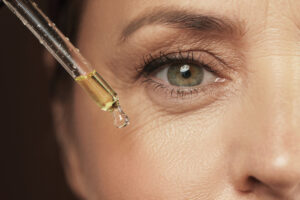Do you know these signs of fatty liver disease?
It is known as nonalcoholic fatty liver disease, or, for short, NAFLD, and it is the most common chronic liver disease. According to the American Liver Foundation, about 30 million Americans have some form of liver disease, and at this point, fatty liver disease is becoming more and more common for those who suffer from obesity and type 2 diabetes.
You can suffer from this condition for years before you get a diagnosis because the symptoms can be subtle and hard to identify. However, there are a few signs of fatty liver disease that show up on your face.
Knowing more about them can tremendously help in identifying the illness and getting an early diagnosis, which can lead to a more effective treatment. Let’s see what the connection is between your face and fatty liver disease.

Is your face connected to your liver?
Fatty liver disease is triggered when your liver stores too much fat and its cells become overwhelmed by it. One of the main causes of this illness is excess alcohol consumption, but there is also NAFLD, which can appear when you have a diet that is high in fat and calories.
When your liver is affected by this disease, inflammation can appear, and sometimes, in more severe cases, the healthy cells of the liver are damaged. Many show no symptoms, while others might feel pain in their abdomen or experience fatigue.
But there are also signs of fatty liver disease that can show up on your face, and we want to tell you more about this.
1. Rosacea
This is a rather rare sign of this liver condition, but there are people who struggle with it, and for many of them, it is a symptom that affects their day-to-day lives.
First of all, we want to mention that rosacea is a chronic skin condition, which means you can’t simply get rid of it. In most cases, you will need to manage it and try to prevent flares. It manifests as flushing, redness of the face, visible blood vessels, and, in rare cases, some might even develop small, red pus-filled bumps.
Generally, fatty liver disease affects only the liver, but sometimes, considering that it causes inflammation, this condition can trigger rosacea in some individuals. There are not many studies about the connection between this liver disease and rosacea, but this article from 2017 found a connection, especially for NAFLD. Also, we need to mention that the study was led by the American Academy of Dermatology.
2. Jaundice
Maybe you have heard this before, and you know that it is usually a sign of liver problems. In more severe cases, when the liver suffers damage, jaundice can appear. The skin turns yellow, as also the white of your eyes.
All of this is caused by surplus bilirubin. When the liver is not functioning properly, this type of waste can build up and show up on your skin, coloring it yellow. If you are not treating this condition, it can worsen, and the color of your skin might turn green. This is no longer caused by the bilirubin but by the bilirubin that is present in the bile.
Depending on the stage of the illness, jaundice can be one of the fatty liver disease signs that you will notice on your face. If you notice your skin turning yellow, you should schedule an appointment with a professional as soon as possible.
3. Darkening of the skin folds
In scientific language, this is known as acanthosis nigricans and is characterized by your skin developing darker patches with a velvety texture in areas that fold, such as your underarms or neck creases. But sometimes these patches can even appear on your face.
This condition can appear in people who are healthy but is also associated with fatty liver disease. Insulin resistance is the main cause, and this happens when your liver is no longer able to use insulin properly.
Increased levels of insulin may trigger skin cell development and increase pigment synthesis, causing the skin to darken and thicken, particularly in acanthosis nigricans. If you have concerns about this, the best thing to do is consult a healthcare professional.
4. Itchy skin
Most of the time, itchy skin, or pruritus, is associated with dermatological conditions, but it is also related to systemic diseases such as fatty liver disease. What we can say is that itchy skin can appear on any part of your body, and this includes the face, which has more sensible skin, so it is more susceptible.
Itchy skin is not a primary symptom of fatty liver disease, but if you notice that your skin starts to itch for no apparent reason, you can talk with your doctor about it and check if your liver is healthy.
Most of the time, this is a complication that appears in those who have an advanced liver illness, and it is strongly associated with liver dysfunction. Impaired liver function causes metabolic imbalances, which can lead to skin dryness and irritation.
When the liver stops producing compounds that are important for the health of your skin, such as fatty acids and ceramides, your skin becomes dry, irritated, and prone to itchiness.
5. Rash around the mouth
Chronic liver diseases, such as fatty liver disease, have major effects on your body, and one of them is the malabsorption of minerals. Zinc is one of the most commonly deficient minerals among those suffering from fatty liver disease. They have a zinc deficiency.
One of the clear signs that someone has a zinc deficiency is dermatitis. A 2022 review showed that this is a pretty common complication of zinc deficiency, and it can appear as a rash around your mouth.
If anything appears on the skin of your face, it is a good idea to consult a dermatologist. This is the only way to find out if this is connected with liver disease or not.

6. Spider veins
Spider angiomas, telangiectasia, or simply spider veins are a condition caused by dilated blood vessels that show up on the surface of the skin and, most of the time, resemble a spider web. While spider veins are frequently linked with veins that are varicose and venous insufficiency, they can also be linked to fatty liver disease.
The most common places for these veins to appear are the legs and the face, but they may also appear on other parts of the body. In cases of liver disease, they appear due to metabolic disturbances, and what you can do is try not to expose them to the sun.
If you want to prevent fatty liver disease, you should do your best to maintain a healthy weight. More than 90% of the severe obesity cases in the US struggle with this illness. Also, limit your alcohol intake and never drink more than two drinks per day for men or one drink per day for women.
One important thing when you suffer from fatty liver disease is your diet. This is how you can manage this disease: by eating healthy food. In this case, the following book contains all the recipes you need, so it might help you: Fatty Liver Diet: Guide And Healthy Recipes To Help Lose Weight And Reverse Fatty Liver
You should also read: Low Blood Pressure in Seniors: The Vital Facts You Should Know



















